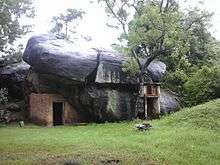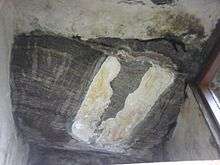Gonagolla Vihara
| Gonagolla Vihara ගොනාගොල්ල විහාරය | |
|---|---|
 A drip ledged cave with frescoes chamber at right side | |
| Basic information | |
| Location | Gonagolla, Ampara, Sri Lanka |
| Geographic coordinates | 07°24′55.9″N 81°39′20.6″E / 7.415528°N 81.655722°ECoordinates: 07°24′55.9″N 81°39′20.6″E / 7.415528°N 81.655722°E |
| Affiliation | Buddhism |
| District | Ampara |
| Province | Eastern Province, Sri Lanka |
| Heritage designation | Archaeological protected monument |
| Architectural description | |
| Architectural type | Buddhist Temple |
| Architectural style | Cave temple |
Gonagolla Vihara (Sinhalaː ගොනාගොල්ල විහාරය) is an ancient Cave temple situated in Ampara District, Sri Lanka. The Vihara is also known as punchi Seegiriya (Little Sigiriya) by the locals since the temple contain ancient frescoes similar to Sigiriya. The site is in Kotmale Canal Settlement in Wewagampattuwa Division and lies about 4.8 km (3.0 mi) east of Kohombana Junction on Ampara – Gonagolla Road. The temple has been formally recognised by the Government as an archaeological site in Sri Lanka.[1]
Frescoes

In 1956 the Archaeological Department found out some remnants of frescoes belong to 3rd century AD on vaulted ceiling of a cave in Gonagolla temple.[2] The frescoes have been drawn on a special plastered surface and depict a scene of young female dancer and a man who is alleged to be a Bodhisattva. The female figure is almost identical to famous Sigiriya maidens (5th century) and both figures have been painted using red, yellow, green and white colors with sharp margins.[1] Due the frescoes, this temple is called Punchi Sigiriya (Little Sigiriya) by locals.[3] Except these frescoes there are some pre-historic paintings drawn by Vedda people can be seen in few rock caves of temple premises.[3]
Ruins

There are clear evidence that the rock caves of the temple were occupied by ancient Vedda people by finding their paintings in nearby premises. Among one of the rock caves, the remains of ancient frescoes, similar to Sigiriya can be seen. Two more cave in the Vihara premises contains Brahmi rock inscriptions dating back to 3-5th centuries.
Although it is believed that some constructions in the Vihara belong to the third century BC.[4] The remains of two ancient ponds, and the Stupa of Anuradhapura era, next to the frescoes cave, are example for them. Among other ruins a Vatadage, Chatra stones, remains of large scale buildings with carved stone pillars and rock stairways can be seen around the temple.
References
- 1 2 "Gonagolla". Department of Archaeology. Retrieved 3 September 2016.
- ↑ "Mural paintings in Sri Lanka, Process of evolution". Daily news. 4 February 2004. Retrieved 3 September 2016.
- 1 2 "Frescoes at Gonagolla Punchi Sigiriya – ගොනාගොල්ල පුංචි සීගිරියේ බිතුසිතුවම්". Amazing Lanka. Retrieved 3 September 2016.
- ↑ "Gonagolla Monastery (Punchi Seegiriya), Ampara". Easternsrilanka. Retrieved 3 September 2016.